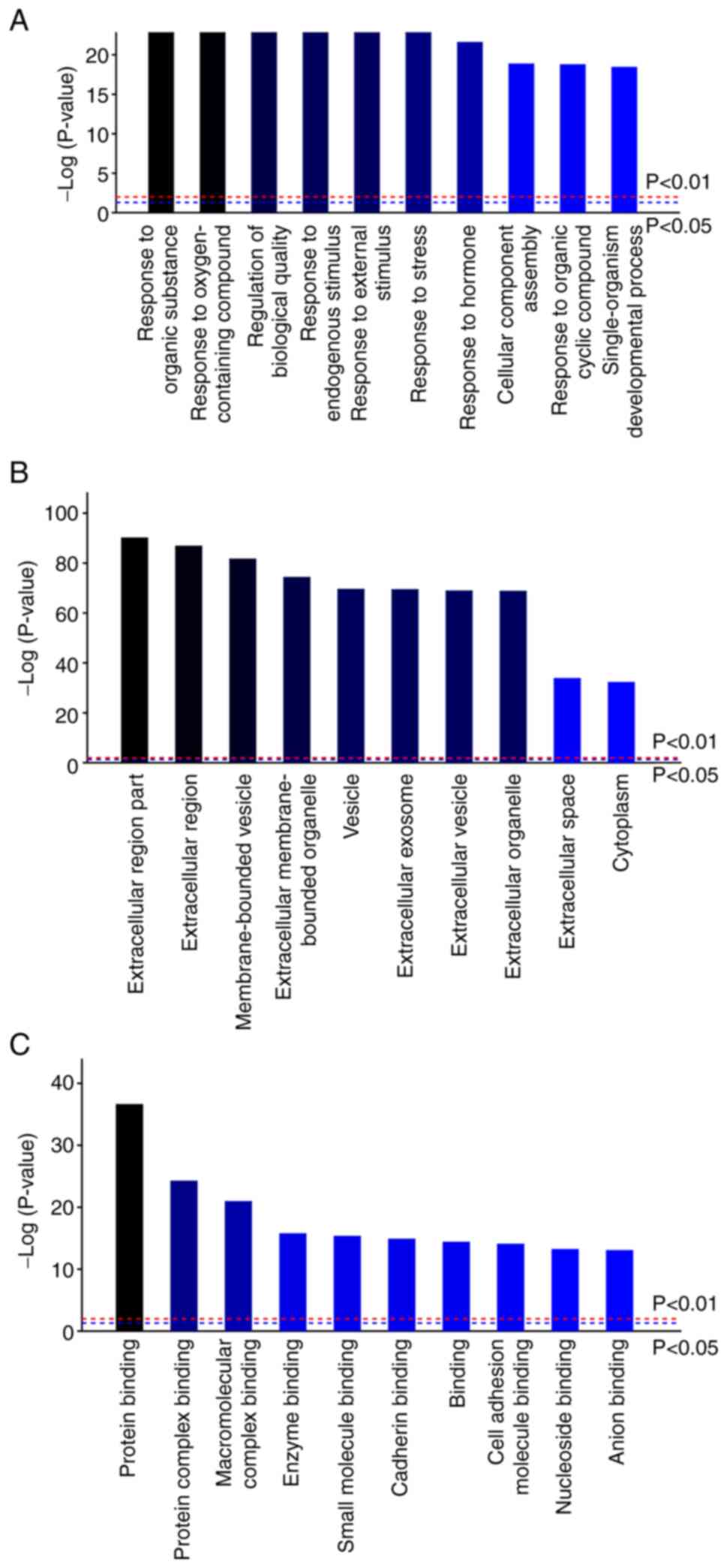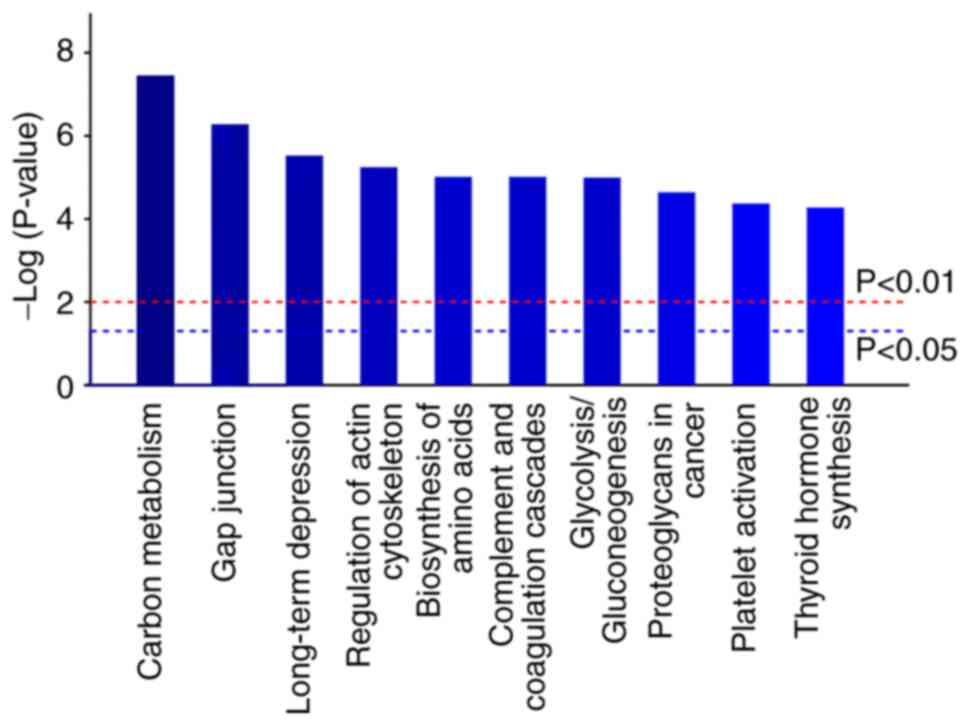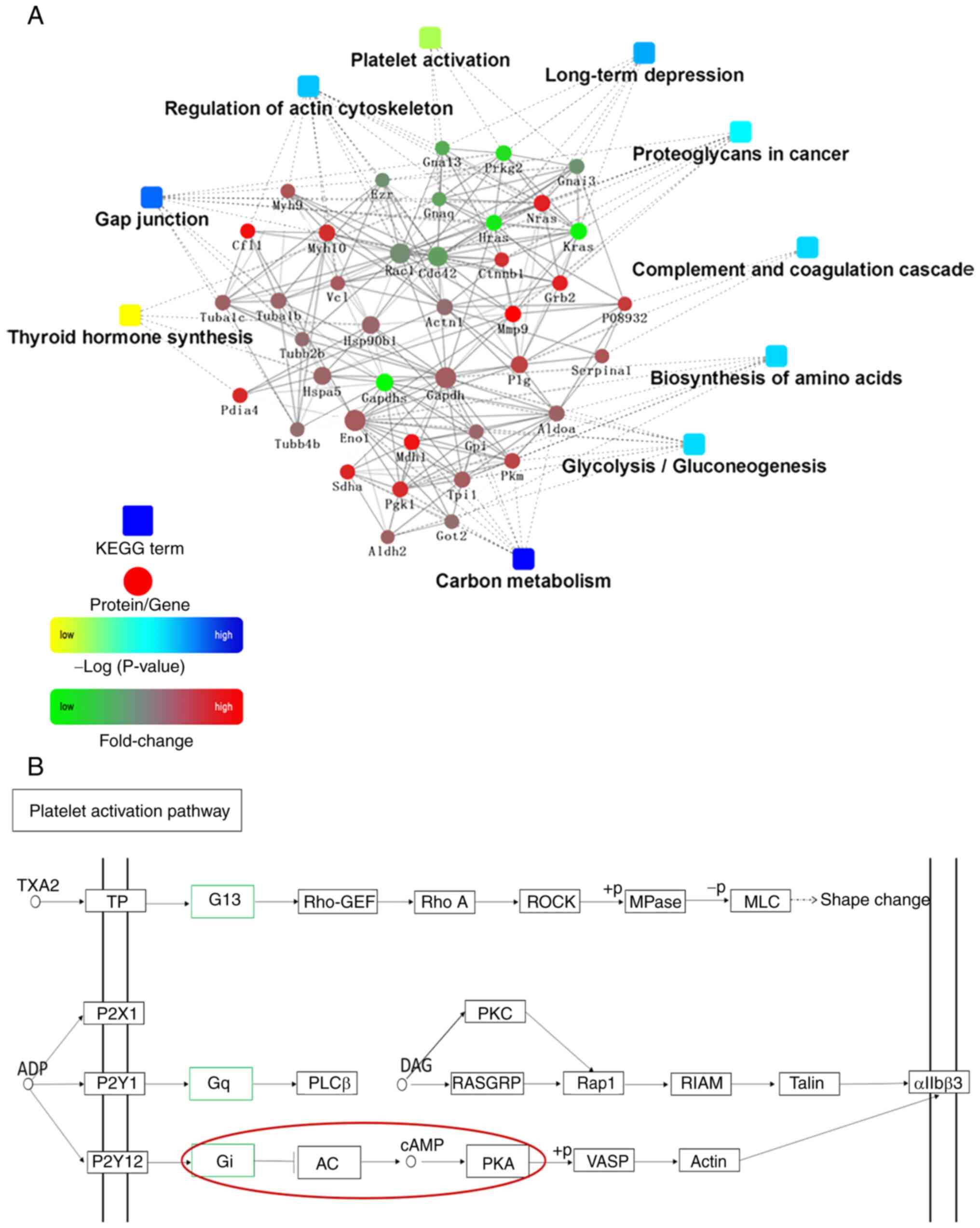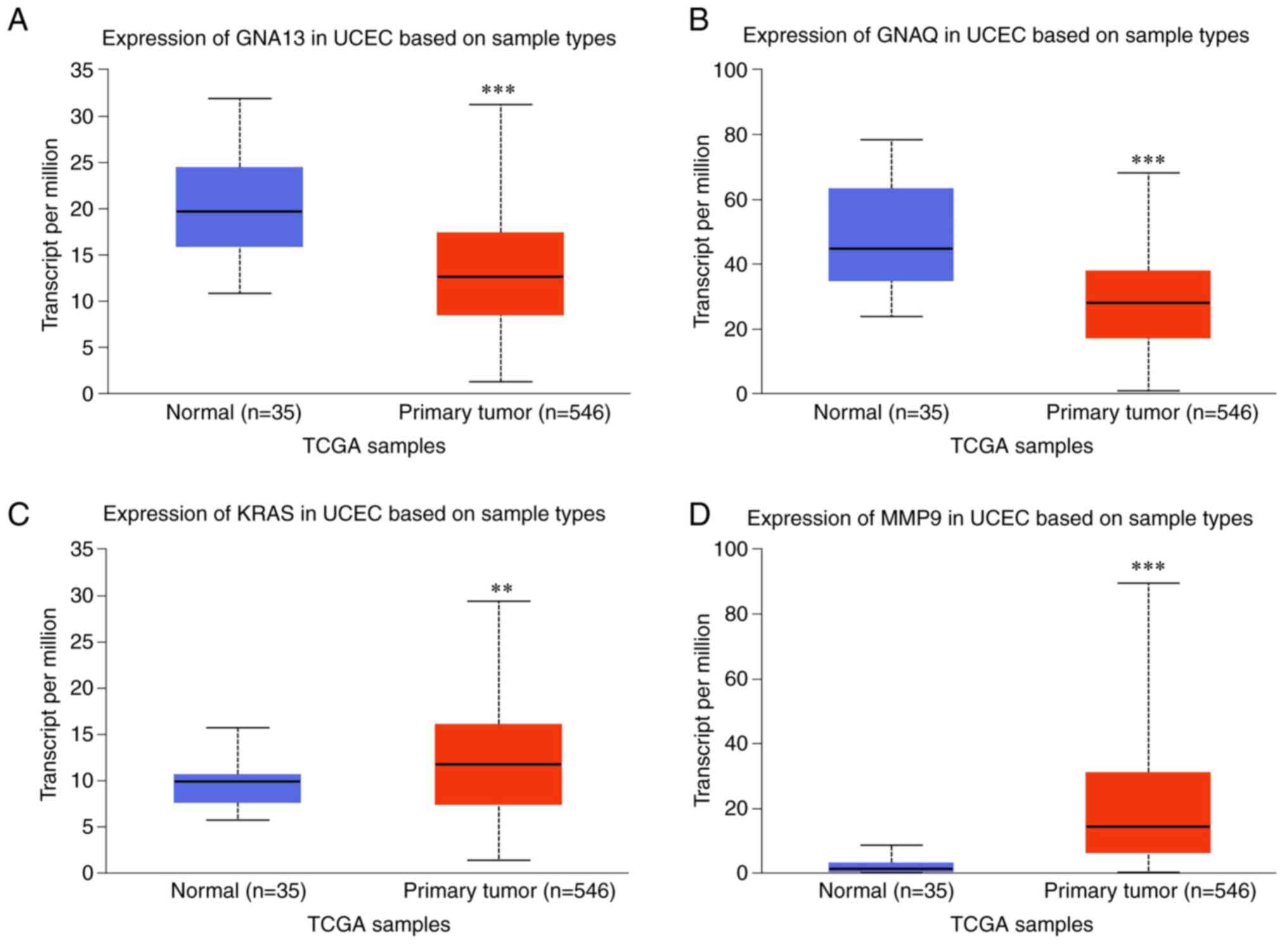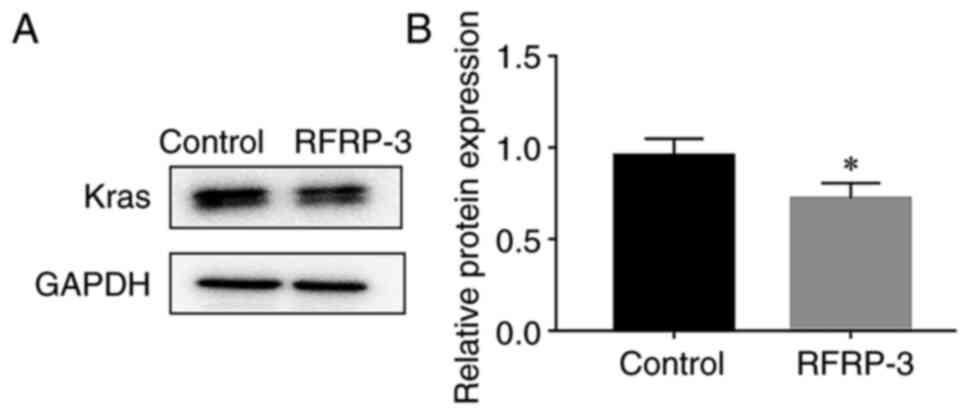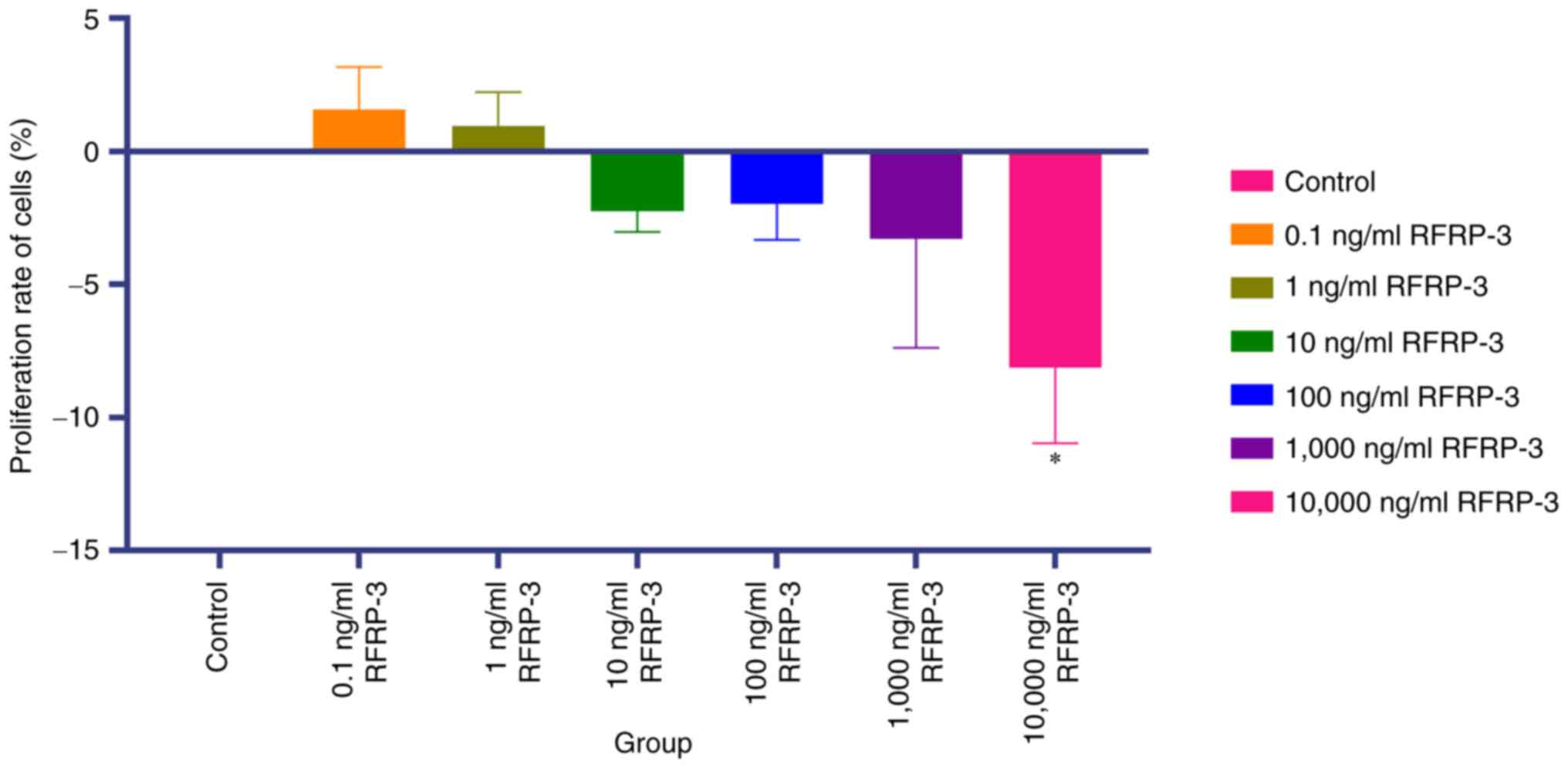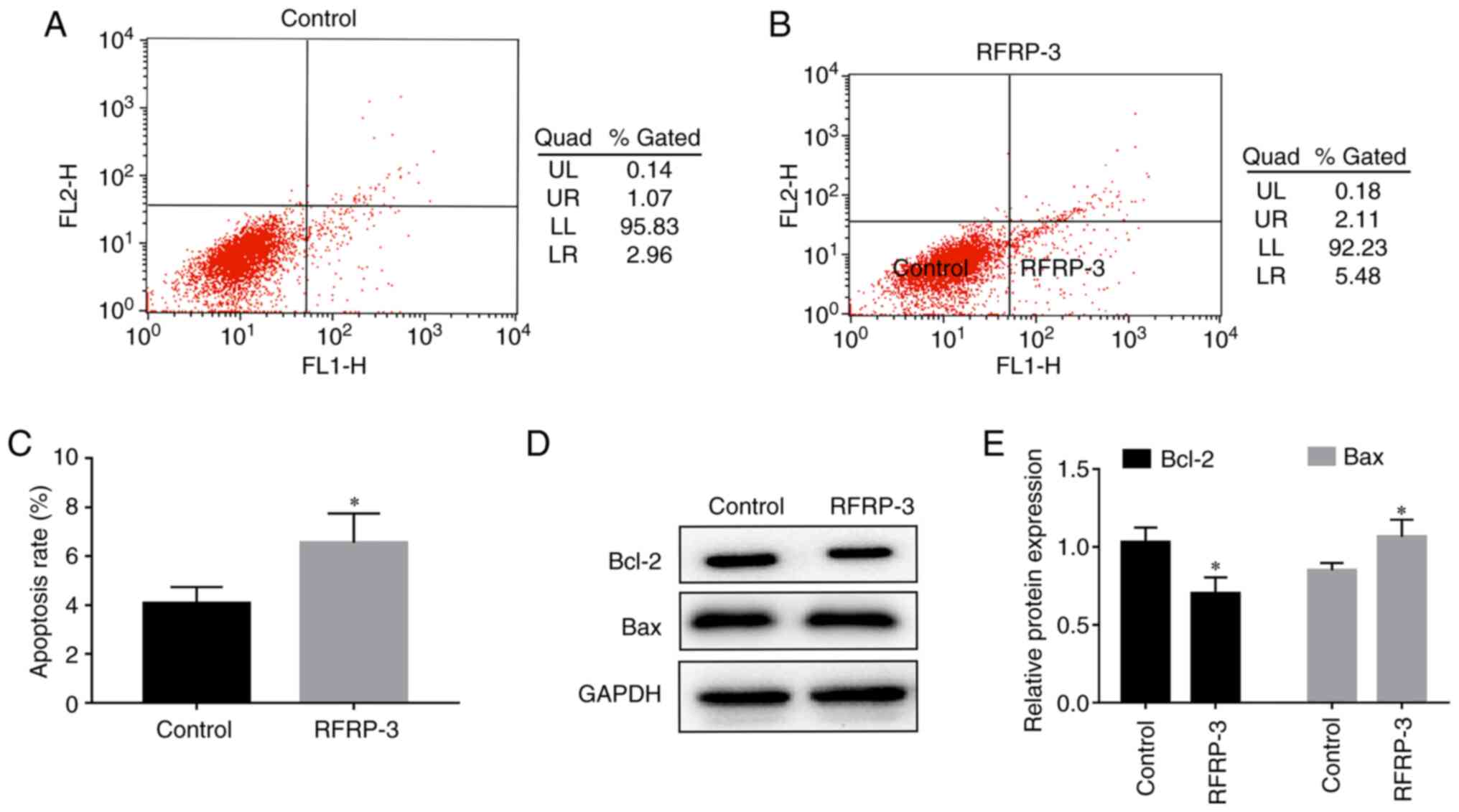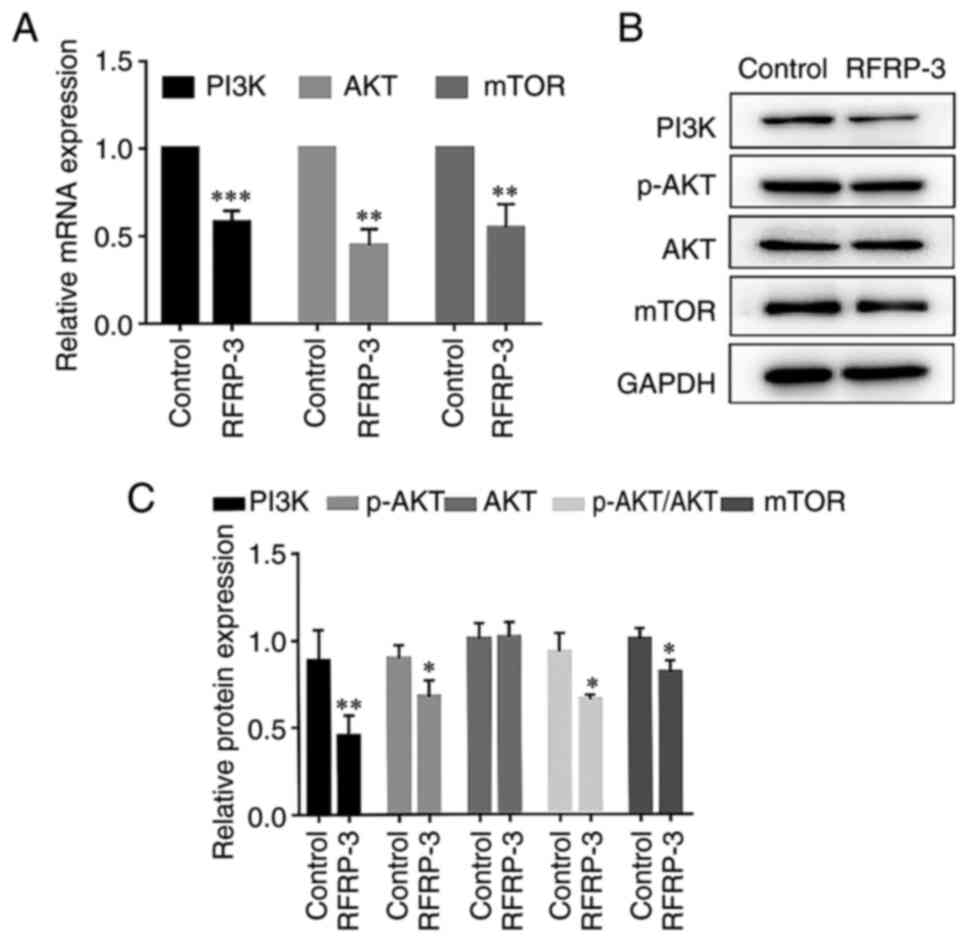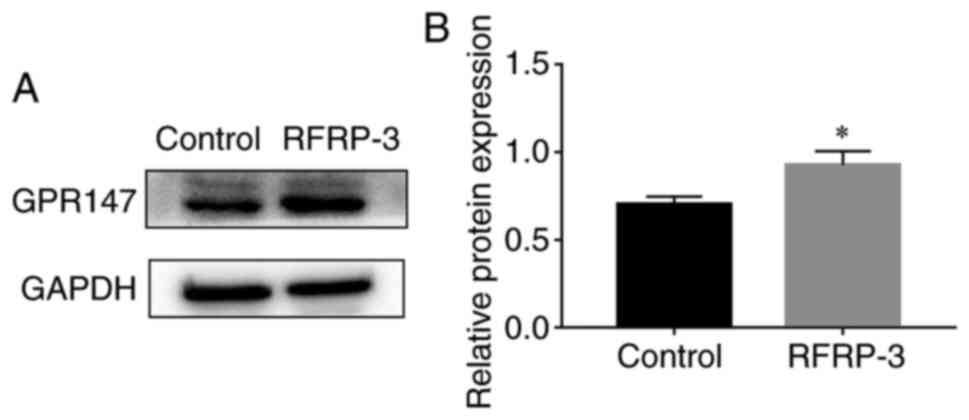|
1
|
Wang X, Guo GL, Zhang X, Li M, Xiao K, Hu
C and Li X: Effect of RFRP-3, the mammalian ortholog of GnIH, on
the epididymis of male rats. Theriogenology. 118:196–202.
2018.PubMed/NCBI View Article : Google Scholar
|
|
2
|
Tsutsui K: A new key neurohormone
controlling reproduction, gonadotropin inhibitory hormone (GnIH):
Biosynthesis, mode of action and functional significance. Prog
Neurobiol. 88:76–88. 2009.PubMed/NCBI View Article : Google Scholar
|
|
3
|
Kriegsfeld LJ, Mei DF, Bentley GE, Ubuka
T, Mason AO, Inoue K, Ukena K, Tsutsui K and Silver R:
Identification and characterization of a gonadotropin-inhibitory
system in the brains of mammals. Proc Natl Acad Sci USA.
103:2410–2415. 2006.PubMed/NCBI View Article : Google Scholar
|
|
4
|
Tsutsui K, Bentley GE, Bedecarrats G,
Osugi T, Ubuka T and Kriegsfeld LJ: Gonadotropin-inhibitory hormone
(GnIH) and its control of central and peripheral reproductive
function. Front Neuroendocrinol. 31:284–295. 2010.PubMed/NCBI View Article : Google Scholar
|
|
5
|
Kriegsfeld LJ, Jennings KJ, Bentley GE and
Tsutsui K: Gonadotrophin-inhibitory hormone and its mammalian
orthologue RFamide-related peptide-3: Discovery and functional
implications for reproduction and stress. Neuroendocrinol.
30(e12597)2018.PubMed/NCBI View Article : Google Scholar
|
|
6
|
Tsutsui K, Ubuka T, Son YL, Bentley GE and
Kriegsfeld LJ: Contribution of GnIH research to the progress of
reproductive neuroendocrinology. Front Endocrinol (Lausanne).
6(179)2015.PubMed/NCBI View Article : Google Scholar
|
|
7
|
Han X, He Y, Zeng G, Wang Y, Sun W, Liu J,
Sun Y and Yu J: Intracerebroventricular injection of RFRP-3 delays
puberty onset and stimulates growth hormone secretion in female
rats. Reprod Biol Endocrinol. 15(35)2017.PubMed/NCBI View Article : Google Scholar
|
|
8
|
Chen L, Si LN, Wei M, Guo S, Yang SH, Chen
ZH, Cheng LY and Qiao YB: Effects of GnIH on hypothalamic POMC
positive neurons in ovariectomized rats supplemented with estrogen.
Chin J Neuroanatomy. 35:57–63. 2019.(In Chinese).
|
|
9
|
Su W, Wei M, Feng C, Yang ZJ, Chen XY,
Cheng LY, Yang SH and Qiao YB: Changes of neuropeptide Y mRNA and
protein expression in hypothalamus of rats after
intracerebroventricular injection of GnIH. Shandong Med J.
56:27–28. 2016.(In Chinese).
|
|
10
|
Wei M, Si LN, Chen L, Yang SH, Cheng LY
and Qiao YB: Regulating effects of GnIH on POMC in hypothalamus of
OEP rats. J Chengde Med College. 34:458–460. 2017.(In Chinese).
|
|
11
|
Chen WP, Witkin JW and Silverman AJ:
Beta-Endorphin and gonadotropin-releasing hormone synaptic input to
gonadotropin-releasing hormone neurosecretory cells in the male
rat. J Comp Neurol. 286:85–95. 1989.PubMed/NCBI View Article : Google Scholar
|
|
12
|
Fetissov SO, Kopp J and Hokfelt T:
Distribution of NPY receptors in the hypothalamus. Neuropeptides.
38:175–188. 2004.PubMed/NCBI View Article : Google Scholar
|
|
13
|
Morelli A, Marini M, Mancina R, Luconi M,
Vignozzi L, Fibbi B, Filippi S, Pezzatini A, Forti G, Vannelli GB
and Maggi M: Sex steroids and leptin regulate the ‘first Kiss’
(KiSS 1/G-protein-coupled receptor 54 system) in human
gonadotropin-releasing-hormone-secreting neuroblasts. J Sex Med.
5:1097–1113. 2008.PubMed/NCBI View Article : Google Scholar
|
|
14
|
Braun MM, Overbeek-Wager EA and Grumbo RJ:
Diagnosis and management of endometrial cancer. Am Fam Physician.
93:468–474. 2016.PubMed/NCBI
|
|
15
|
Gompel A: Progesterone and endometrial
cancer. Best Pract Res Clin Obstet Gynaecol. 69:95–107.
2020.PubMed/NCBI View Article : Google Scholar
|
|
16
|
Corzo C, Barrientos Santillan N, Westin SN
and Ramirez PT: Updates on conservative management of endometrial
cancer. J Minim Invasive Gynecol. 25:308–313. 2018.PubMed/NCBI View Article : Google Scholar
|
|
17
|
Emons G and Gründker C: The role of
gonadotropin-releasing hormone (GnRH) in endometrial cancer. Cells.
10(292)2021.PubMed/NCBI View Article : Google Scholar
|
|
18
|
Grundker C, Gunthert AR, Westphalen S and
Emons G: Biology of the gonadotropin-releasing hormone system in
gynecological cancers. Eur J Endocrinol. 146:1–14. 2002.PubMed/NCBI View Article : Google Scholar
|
|
19
|
Emons G, Grundker C, Gunthert AR,
Westphalen S, Kavanagh J and Verschraegen C: GnRH antagonists in
the treatment of gynecological and breast cancers. Endocr Relat
Cancer. 10:291–299. 2003.PubMed/NCBI View Article : Google Scholar
|
|
20
|
Fister S, Günthert AR, Aicher B, Paulini
KW, Emons G and Gründker C: GnRH-II antagonists induce apoptosis in
human endometrial, ovarian, and breast cancer cells via activation
of stress-induced MAPKs p38 and JNK and proapoptotic protein Bax.
Cancer Res. 69:6473–6481. 2009.PubMed/NCBI View Article : Google Scholar
|
|
21
|
Livak KJ and Schmittgen TD: Analysis of
relative gene expression data using real-time quantitative PCR and
the 2(-Delta Delta C(T)) Method. Methods. 25:402–408.
2001.PubMed/NCBI View Article : Google Scholar
|
|
22
|
Ukena K and Tsutsui K: A new member of the
hypothalamic RF-amide peptide family, LPXRF-amide peptides:
Structure, localization and function. Mass Spectrom Rev.
24:469–486. 2005.PubMed/NCBI View Article : Google Scholar
|
|
23
|
Tsutsui K and Ukena K: Hypothalamic
LPXRF-amide peptides in vertebrates: Identification, localization
and hypophysiotropic activity. Peptides. 27:1121–1129.
2006.PubMed/NCBI View Article : Google Scholar
|
|
24
|
Tsutsui K: How to contribute to the
progress of neuroendocrinology: New insights from discovering novel
neuropeptides and neurosteroids regulating pituitary and brain
functions. Gen Comp Endocrinol. 227:3–15. 2016.PubMed/NCBI View Article : Google Scholar
|
|
25
|
Tsutsui K and Ubuka T: GnIH control of
feeding and reproductive behaviors. Front Endocrinol (Lausanne).
7(170)2016.PubMed/NCBI View Article : Google Scholar
|
|
26
|
Ukena K, Iwakoshi E, Minakata H and
Tsutsui K: A novel rat hypothalamic RFamide-related peptide
identified by immunoaffinity chromatography and mass spectrometry.
FFBS Lett. 512:255–258. 2002.PubMed/NCBI View Article : Google Scholar
|
|
27
|
Ubuka T, Morgan K, Pawson AJ, Osugi T,
Chowdhury VS, Minakata H, Tsutsui K, Millar RP and Bentley GE:
Identification of human GnIH homologs, RFRP-1 and RFRP-3, and the
cognate receptor, GPR147 in the human hypothalamic pituitary axis.
PLoS One. 4(e8400)2009.PubMed/NCBI View Article : Google Scholar
|
|
28
|
Ubuka T, Inoue K, Fukuda Y, Mizuno T,
Ukena K, Kriegsfeld LJ and Tsutsui K: Identification, expression,
and physiological functions of Siberian hamster
gonadotropin-inhibitory hormone. Endocrinology. 153:373–385.
2012.PubMed/NCBI View Article : Google Scholar
|
|
29
|
Li H: The expression of RFRP-3 in lamb
tissue uses and its role between nutrition and reproduction
(unpublished PhD thesis). Nanjing Agricultural University,
2014.
|
|
30
|
Liu J: The cloning mRNA expression of GnIH
and its receptors in rabbit (unpublished PhD thesis). Nanjing
Agricultural University, 2011.
|
|
31
|
Li X, Su J, Lei Z, Zhao Y, Jin M, Fang R,
Zheng L and Jiao Y: Gonadotropin-inhibitory hormone (GnIH) and its
receptor in the female pig: cDNA cloning, expression in tissues and
expression pattern in the reproductive axis during the estrous
cycle. Peptides. 36:176–185. 2012.PubMed/NCBI View Article : Google Scholar
|
|
32
|
Hinuma S, Shintani Y, Fukusumi S, Iijima
N, Matsumoto Y, Hosoya M, Fujii R, Watanabe T, Kikuchi K, Terao Y,
et al: New neuropeptides containing carboxy-terminal RFamide and
their receptor in mammals. Nat Cell Biol. 2:703–708.
2000.PubMed/NCBI View Article : Google Scholar
|
|
33
|
Ubuka T, Son YL, Bentley GE, Millar RP and
Tsutsui K: Gonadotropin-inhibitory hormone (GnIH), GnIH receptor
and cell signaling. Gen Comp Endocrinol. 190:10–17. 2013.PubMed/NCBI View Article : Google Scholar
|
|
34
|
Bonini JA, Jones KA, Adham N, Forray C,
Artymyshyn R, Durkin MM, Smith KE, Tamm JA, Boteju LW, Lakhlani PP,
et al: Identification and characterization of two G protein-coupled
receptors for neuropeptide FF. J Biol Chem. 275:39324–39331.
2000.PubMed/NCBI View Article : Google Scholar
|
|
35
|
Son YL, Ubuka T, Millar RP, Kanasaki H and
Tsutsui K: Gonadotropin-inhibitory hormone inhibits GnRH-induced
gonadotropin subunit gene transcriptions by inhibiting
AC/cAMP/PKA-dependent ERK pathway in LβT2 cells. Endocrinology.
153:2332–2343. 2012.PubMed/NCBI View Article : Google Scholar
|
|
36
|
Johnson MA, Tsutsui K and Fraley GS: Rat
RFamide-related peptide-3 stimulates GH secretion, inhibits LH
secretion, and has variable effects on sex behavior in the adult
male rat. Horm Behav. 51:171–180. 2007.PubMed/NCBI View Article : Google Scholar
|
|
37
|
Piekarski DJ, Zhao S, Jennings KJ, Iwasa
T, Legan SJ, Mikkelsen JD, Tsutsui K and Kriegsfeld LJ:
Gonadotropin-inhibitory hormone reduces sexual motivation but not
lordosis behavior in female Syrian hamsters (Mesocricetus auratus).
Horm Behav. 64:501–510. 2013.PubMed/NCBI View Article : Google Scholar
|
|
38
|
Qi Y, Oldfield BJ and Clarke IJ:
Projections of RFamide-related peptide-3 neurons in the ovine
hypothalamus, with special reference to rigions regulating energy
balance and reproduction. J Neuroendocrinol. 21:690–697.
2009.PubMed/NCBI View Article : Google Scholar
|
|
39
|
Clarke IJ, Smith JT, Henry BA, Oldfield
BJ, Stefanidis A, Millar RP, Sari IP, Chng K, Fabre-Nys C, Caraty
A, et al: Gonadotropin-inhibitory hormone is a hypothalamic peptide
that provides a molecular switch between reproduction and feeding.
Neuroendocrinology. 95:305–316. 2012.PubMed/NCBI View Article : Google Scholar
|
|
40
|
Kaewwongse M, Takayanagi Y and Onaka T:
Effects of RFamide-related Peptide (RFRP)-1 and RFRP-3 on oxytocin
release and anxiety-related behaviour in rats. J Neuroendocrinol.
23:20–27. 2011.PubMed/NCBI View Article : Google Scholar
|
|
41
|
Lee RS, Wheeler TT and Peterson AJ:
Large-format, two-dimensional polyacrylamide gel electrophoresis of
ovine periimplantation uterine luminal fluid proteins:
Identification of aldose reductase, cytoplasmic actin, and
transferrin as conceptus-synthesized proteins. Biol Reprod.
59:743–752. 1998.PubMed/NCBI View Article : Google Scholar
|
|
42
|
Cheng LY, Yang SH, Sun TC, Wang XQ, Hu W,
Qi XW and Yu HM: Identification of an unknown uterine estrogen
reactive protein ULF-250. Chin J Biochem Mol Biology. 25:60–64.
2009.(In Chinese).
|
|
43
|
Fuller GG and Kim JK: Compartmentalization
and metabolic regulation of glycolysis. J Cell Sci.
134(jcs258469)2021.PubMed/NCBI View Article : Google Scholar
|
|
44
|
Vettore L, Westbrook RL and Tennant DA:
New aspects of amino acid metabolism in cancer. Br J Cancer.
122:150–156. 2020.PubMed/NCBI View Article : Google Scholar
|
|
45
|
Narisawa S, Hecht NB, Goldberg E,
Boatright KM, Reed JC and Millán JL: Testis-specific cytochrome
c-null mice produce functional sperm but undergo early testicular
atrophy. Mol Cell Biol. 22:5554–5562. 2002.PubMed/NCBI View Article : Google Scholar
|
|
46
|
Boussouar F and Benahmed M: Lactate and
energy metabolism in male germ cells. Trends Endocrinol Metab.
15:345–350. 2004.PubMed/NCBI View Article : Google Scholar
|
|
47
|
Alvarez GM, Casiró S, Gutnisky C, Alvarez
G, Dalvit GC, Sutton-McDowall ML, Thompson JG and Cetica PD:
Implications of glycolytic and pentose phosphate pathways on the
oxidative status and active mitochondria of the porcine oocyte
during IVM. Theriogenology. 86:2096–2106. 2016.PubMed/NCBI View Article : Google Scholar
|
|
48
|
Ren J, He J, Zhang H, Xia Y, Hu Z,
Loughran P, Billiar T, Huang H and Tsung A: Platelet TLR4-ERK5 axis
facilitates NET-Mediated capturing of circulating tumor cells and
distant metastasis after surgical stress. Cancer Res. 81:2373–2385.
2021.PubMed/NCBI View Article : Google Scholar
|
|
49
|
Silva JF, Ocarino NM and Serakides R:
Thyroid hormones and female reproduction. Biol Reprod. 99:907–921.
2018.PubMed/NCBI View Article : Google Scholar
|
|
50
|
Haraguchi S, Hara S, Ubuka T, Mita M and
Tsutsui K: Possible role of pineal allopregnanolone in Purkinje
cell survival. Proc Natl Acad Sci USA. 109:21110–21115.
2012.PubMed/NCBI View Article : Google Scholar
|
|
51
|
Sideris M, Emin EI, Abdullah Z, Hanrahan
J, Stefatou KM, Sevas V, Emin E, Hollingworth T, Odejinmi F,
Papagrigoriadis S, et al: The Role of KRAS in endometrial cancer: A
mini-review. Anticancer Res. 39:533–539. 2019.PubMed/NCBI View Article : Google Scholar
|
|
52
|
Bulsa M and Urasińska E: Triple negative
endometrial cancer. Ginekol Pol. 88:212–214. 2017.PubMed/NCBI View Article : Google Scholar
|
|
53
|
Vitale SG, Valenti G, Gulino FA, Cignini P
and Biondi A: Surgical treatment of high stage endometrial cancer:
Current perspectives. Updates Surg. 68:149–154. 2016.PubMed/NCBI View Article : Google Scholar
|
|
54
|
Cheng L, Yang S, Si L, Wei M, Guo S, Chen
Z, Wang S and Qiao Y: Direct effect of RFRP-3 microinjection into
the lateral ventricle on the hypothalamic kisspeptin neurons in
ovariectomized estrogen-primed rats. Exp Ther Med.
23(24)2022.PubMed/NCBI View Article : Google Scholar
|
|
55
|
Son YL, Ubuka T and Tsutsu K: Molecular
mechanisms of gonadotropin-inhibitory Hormone(GnIH) actions in
target cells and regulation of GnIH expression. Front Endocrinol
(Lausanne). 10(110)2019.PubMed/NCBI View Article : Google Scholar
|
|
56
|
Son YL, Ubuka T, Soga T, Yamamoto K,
Bentley GE and Tsutsui K: Inhibitory action of
gonadotropin-inhibitory hormone on the signaling pathways induced
by kisspeptin and vasoactive intestinal polypeptide in GnRH
neuronal cell line,GT1-7. FASEB J. 30:2198–2210. 2016.PubMed/NCBI View Article : Google Scholar
|
|
57
|
Sukhbaatar U, Kanasaki H, Mijiddorj T,
Oride A and Miyazaki K: Kisspeptin induces expression of
gonadotropin-releasing hormone receptor in GnRH-producing GT1-7
cells overexpressing G protein-coupled receptor 54. Gen Comp
Endocrinol. 194:94–101. 2013.PubMed/NCBI View Article : Google Scholar
|
|
58
|
Hara T, Kanasaki H, Tumurbaatar T, Oride
A, Okada H and Kyo S: Role of Kisspeptin and Kiss1R in the
regulation of prolactin gene expression in aat somatolactotroph GH3
cells. Endocrine. 63:101–111. 2019.PubMed/NCBI View Article : Google Scholar
|
|
59
|
Rasheed SAK, Teo CR, Beillard EJ,
Voorhoeve PM and Casey PJ: MicroRNA-182 and microRNA-200a control
G-protein subunit α-13(GNA13) expression and cell invasion
synergistically in prostate cancer cells. J Biol Chem.
288:7986–7995. 2013.PubMed/NCBI View Article : Google Scholar
|
|
60
|
Muhammad S, Tang Q, Wei L, Zhang Q, Wang
G, Muhammad BU, Kaur K, Kamchedalova T, Gang Z, Jiang Z, et al:
miRNA-30d serves a critical function in colorectal cancer
initiation, progression and invasion via directly targeting the
GNA13 gene. Exp Ther Med. 17:260–272. 2019.PubMed/NCBI View Article : Google Scholar
|
|
61
|
Jayaraman M, Radhakrishnan R, Mathews CA,
Yan M, Husain S, Moxley KM, Song YS and Dhanasekaran DN:
Identification of novel diagnostic and prognostic miRNA signatures
in endometrial cancer. Genes Cancer. 8:566–576. 2017.PubMed/NCBI View Article : Google Scholar
|
|
62
|
Padol AR, Sukumaran VS, Sadam A, Kesavan
M, Arunvikram K, Verma AD, Srivastava V, Panigrahi M, Singh TU,
Telang AG, et al: Hypercholesterolemia impairs oxytocin-induced
uterine contractility in late pregnant mouse. Reproduction.
53:565–576. 2017.PubMed/NCBI View Article : Google Scholar
|
|
63
|
Staff S, Aaltonen M, Huhtala H,
Pylvänäinen K, Mecklin JP and Mäenpää J: Endometrial Cancer risk
factors among lynch syndrome women: A retrospective cohort study.
Br J Cancer. 115:375–381. 2016.PubMed/NCBI View Article : Google Scholar
|
|
64
|
Martin-Belmonte F and Perez-Moreno M:
Epithelial cell polarity, stem cells and cancer. Nat Rev Cancer.
12:23–38. 2012.PubMed/NCBI View Article : Google Scholar
|
|
65
|
Knoblich JA: Asymmetric cell division:
Recent developments and their implications for tumour biology. Nat
Rev Mol Cell Biol. 11:849–860. 2010.PubMed/NCBI View Article : Google Scholar
|
|
66
|
Gonzalez C: Spindle orientation,
asymmetric division and tumour suppression in Drosophila stem
cells. Nat Rev Genet. 8:462–472. 2007.PubMed/NCBI View Article : Google Scholar
|
|
67
|
Williams ES, Ratliff AL, Postiglione MP,
Knoblich JA and Fuchs E: Par3-mInsc and Gαi3 cooperate to promote
oriented epidermal cell divisions through LGN. Nat Cell Biol.
16:758–769. 2014.PubMed/NCBI View Article : Google Scholar
|
|
68
|
Karahan N, Güney M, Baspinar S, Oral B,
Kapucuoglu N and Mungan T: Expression of gelatinase (MMP-2 and
MMP-9) and cyclooxygenase-2(COX-2) in endometrial cancer. Eur J
Gynaecol Oncol. 28:184–188. 2007.PubMed/NCBI
|
|
69
|
Iurlaro M, Loverro G, Vacca A, Cormio G,
Ribatti D, Minischetti M, Ria R, Bruno M and Selvaggi L:
Angiogenesis extent and expression of matrix metalloproteinase-2
and -9 correlate with upgrading and myometrial invasion in
endometrial cancer. Eur J Clin Invest. 29:793–801. 1999.PubMed/NCBI View Article : Google Scholar
|
|
70
|
Graesslin O, Cortez A, Fauvet R, Lorenzato
M, Birembaut P and Daraï E: Metalloproteinase-2, -7 and -9 and
tissue inhibitor of metalloproteinase-1 and -2 expression in
normal, hyperplastic and neoplastic endometrium: A
clinical-pathological correlation study. Ann Oncol. 17:637–645.
2006.PubMed/NCBI View Article : Google Scholar
|
|
71
|
Srdelić Mihalj S, Kuzmić-Prusac I,
Zekić-Tomaš S, Šamija-Projić I and Čapkun V: Lipocalin-2 and matrix
metalloproteinase-9 expression in high-grade endometrial cancer and
their prognostic value. Histopathology. 67:206–215. 2015.PubMed/NCBI View Article : Google Scholar
|
|
72
|
Barra F, Evangelisti G, Ferro Desideri L,
Di Domenico S, Ferraioli D, Vellone VG, De Cian F and Ferrero S:
Investigational PI3K/AKT/mTOR inhibitors in development for
endometrial cancer. Expert Opin Investig Drugs. 28:131–142.
2019.PubMed/NCBI View Article : Google Scholar
|
|
73
|
Wullschleger S, Loewith R and Hall MN: TOR
signaling in growth and metabolism. Cell. 124:471–484.
2006.PubMed/NCBI View Article : Google Scholar
|
|
74
|
Vishnupriya S, Priya Dharshini LC,
Sakthivel KM and Rasmi RR: Autophagy markers as mediators of lung
injury-implication for therapeutic intervention. Life Sci.
260(118308)2020.PubMed/NCBI View Article : Google Scholar
|















